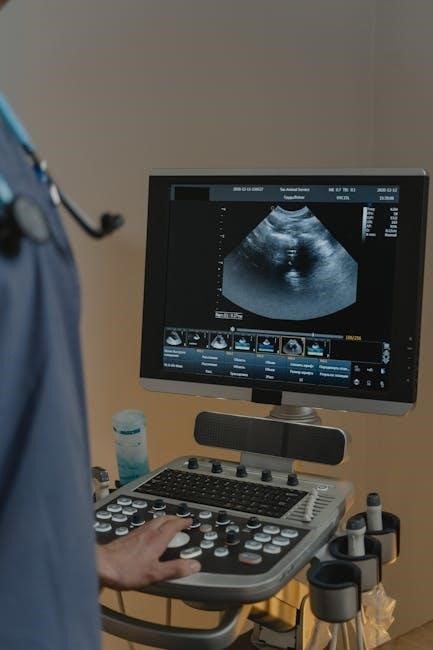The TPM Operator Checklist PDF is a comprehensive guide designed to streamline maintenance processes, ensuring equipment efficiency and reliability. It includes daily, weekly, and monthly tasks.
This checklist provides operators with clear, actionable steps to perform routine maintenance, reducing downtime and enhancing overall productivity. It serves as a vital tool for TPM implementation success.
1.1 Overview of Total Productive Maintenance (TPM)
TPM, or Total Productive Maintenance, is a holistic maintenance methodology aimed at maximizing equipment efficiency and productivity. It combines preventive maintenance with total quality control and employee involvement. TPM emphasizes proactive maintenance to minimize downtime and extend equipment lifespan. It fosters a culture where all employees, from operators to managers, contribute to maintaining equipment health. By integrating Autonomous Maintenance (AM) and Planned Maintenance (PM), TPM ensures equipment operates at its optimal level. This approach reduces production losses and enhances overall plant performance, making it a cornerstone of lean manufacturing and operational excellence. TPM is widely adopted across industries to achieve zero breakdowns, defects, and accidents.
1.2 Importance of a TPM Operator Checklist
A TPM Operator Checklist is essential for ensuring consistency and accountability in maintenance activities. It provides operators with a structured approach to perform daily, weekly, and monthly tasks, reducing the likelihood of human error. By following the checklist, operators can identify potential issues early, preventing equipment downtime and extending its lifespan. The checklist also promotes a culture of proactive maintenance, empowering operators to take ownership of equipment health. This tool is particularly valuable in industries where operational efficiency and safety are critical. Regular use of the checklist enhances overall productivity, reduces maintenance costs, and aligns with TPM goals of achieving zero breakdowns and defects.
1.3 Purpose of the TPM Operator Checklist PDF
The TPM Operator Checklist PDF serves as a structured guide to ensure effective implementation of Total Productive Maintenance practices. Its primary purpose is to provide operators with a clear, step-by-step framework for performing daily, weekly, and monthly maintenance tasks. This checklist helps in identifying potential equipment issues early, preventing unplanned downtime, and improving overall operational efficiency. By standardizing maintenance procedures, it enhances equipment reliability, reduces costs, and promotes a proactive maintenance culture. The checklist also acts as a training tool, empowering operators to take ownership of equipment health and aligning their activities with broader TPM goals.

Key Concepts of TPM
TPM integrates preventive maintenance, quality control, and employee involvement to maximize equipment efficiency and lifespan. It focuses on proactive maintenance to minimize downtime and enhance productivity.
2.1 The Eight Pillars of TPM
The Eight Pillars of TPM form the foundation of a successful maintenance strategy. These pillars include: Autonomous Maintenance (AM), Planned Maintenance (PM), Focused Improvement (FI), Quality Maintenance (QM), Early Equipment Management (EEM), Developmental Maintenance (DM), Administrative Maintenance (AdM), and Safety, Health, and Environment (SHE). Each pillar plays a critical role in achieving zero downtime, defects, and accidents. Autonomous Maintenance empowers operators to perform routine tasks, while Planned Maintenance ensures scheduled upkeep. Focused Improvement drives continuous enhancement, and Quality Maintenance prevents defects. Early Equipment Management optimizes new equipment, and Developmental Maintenance improves maintenance skills. Administrative Maintenance supports overall TPM processes, ensuring sustainability and safety.
2.2 Autonomous Maintenance (AM)
Autonomous Maintenance (AM) is a core pillar of TPM, empowering machine operators to take ownership of routine maintenance tasks. This includes daily checks, cleaning, lubrication, and minor adjustments. By involving operators directly, AM fosters a proactive approach to equipment care, reducing reliance on maintenance teams. Operators develop deeper understanding of their equipment, enabling early detection of potential issues. Regular AM activities are outlined in the TPM Operator Checklist PDF, ensuring consistency and accountability. This practice not only enhances equipment reliability but also promotes a culture of continuous improvement and operator engagement, which are essential for achieving TPM goals and minimizing downtime.
2.3 Planned Maintenance (PM)
Planned Maintenance (PM) is a proactive approach to scheduling and performing maintenance tasks at fixed intervals. It aims to prevent equipment failures, reduce downtime, and optimize operational efficiency. PM activities, such as inspections, parts replacement, and servicing, are typically outlined in the TPM Operator Checklist PDF. This structured approach ensures that maintenance is performed consistently and effectively, addressing potential issues before they escalate. By integrating PM with other TPM pillars like Autonomous Maintenance (AM) and Focused Improvement (FI), organizations can achieve a balanced and sustainable maintenance strategy. The checklist provides clear guidelines, helping operators and maintenance teams align their efforts for improved productivity and reliability.
2.4 Focused Improvement (FI)
Focused Improvement (FI) is a pillar of TPM centered on identifying and addressing specific problems affecting equipment performance; It involves systematic analysis and targeted actions to eliminate losses and improve efficiency. FI encourages cross-functional teams to collaborate in root cause analysis and implement corrective measures. The TPM Operator Checklist PDF often includes sections for documenting issues, tracking progress, and verifying improvements. By fostering a culture of continuous improvement, FI helps organizations reduce operational inefficiencies and enhance overall equipment effectiveness. This structured approach ensures that improvements are sustainable and aligned with broader TPM goals, contributing to long-term operational excellence and reliability.
2.5 Quality Maintenance (QM)
Quality Maintenance (QM) is a TPM pillar focused on preventing defects and ensuring high-quality production. It integrates quality control with maintenance activities, emphasizing proactive measures to avoid equipment failures. QM involves implementing precise maintenance schedules, improving production processes, and training operators to identify potential quality issues early. The TPM Operator Checklist PDF often includes QM-specific tasks, such as equipment calibration checks and defect prevention strategies. By prioritizing quality in maintenance, organizations can reduce waste, enhance customer satisfaction, and achieve higher overall equipment effectiveness. QM plays a crucial role in sustaining TPM goals and fostering a culture of zero defects in manufacturing environments.
2.6 Early Equipment Management (EEM)
Early Equipment Management (EEM) focuses on managing equipment from its design phase to retirement, ensuring optimal performance throughout its lifecycle. It involves proactive planning, design reviews, and lifecycle maintenance strategies. The TPM Operator Checklist PDF often includes EEM tasks such as equipment design evaluations, installation checks, and commissioning procedures. By addressing potential issues early, EEM helps reduce downtime, extends equipment lifespan, and improves overall productivity. This pillar emphasizes collaboration between design, maintenance, and operations teams to create a seamless equipment management process, aligning with TPM’s goal of achieving zero breakdowns and maximum efficiency.
2.7 Developmental Maintenance (DM)
Developmental Maintenance (DM) focuses on improving equipment performance and addressing recurring issues. It involves analyzing breakdown patterns and implementing modifications to enhance reliability. The TPM Operator Checklist PDF often includes DM tasks such as root cause analysis, upgrading components, and testing improvements. By targeting specific equipment problems, DM aims to reduce maintenance frequency and extend equipment lifespan. This pillar promotes continuous improvement, ensuring that equipment evolves to meet operational demands. Regular updates and modifications are documented to track progress and refine maintenance strategies, aligning with TPM’s goal of achieving zero breakdowns and maximizing efficiency.
2.8 Administrative Maintenance (AdM)
Administrative Maintenance (AdM) focuses on managing and organizing maintenance activities effectively. It ensures that all maintenance tasks are documented, scheduled, and tracked. The TPM Operator Checklist PDF often includes sections for maintaining records, updating schedules, and coordinating between teams. AdM involves creating and managing maintenance plans, ensuring compliance with standards, and auditing processes to identify inefficiencies. This pillar supports the other TPM activities by providing a structured framework for execution. By streamlining administrative tasks, AdM enhances overall maintenance efficiency and ensures that resources are utilized optimally. It plays a crucial role in sustaining TPM implementation and achieving long-term operational excellence.

Sections of the TPM Operator Checklist
The TPM Operator Checklist is divided into daily, weekly, and monthly tasks, providing a structured approach to maintenance activities and ensuring consistent equipment upkeep.
3.1 Daily TPM Tasks
Daily TPM tasks form the foundation of proactive maintenance, ensuring equipment operates efficiently. These tasks include visual inspections, cleaning, lubrication, and tightening of bolts and fasteners. Operators perform checks on fluid levels, monitor for unusual noises or vibrations, and record any deviations. Additionally, daily walk-around inspections are conducted to identify potential issues before they escalate. These routine activities not only prevent unexpected downtime but also contribute to a safer working environment. By consistently following the checklist, operators play a crucial role in maintaining equipment health and upholding productivity standards. Regular execution of these tasks fosters a culture of continuous improvement within the organization.
3.2 Weekly TPM Tasks
Weekly TPM tasks build upon daily routines, focusing on more detailed checks and preventive measures. Operators typically inspect belts, hoses, and other wear-prone components for signs of deterioration. Air and oil filters are checked and replaced as needed, while electrical connections and wiring are verified for integrity. Weekly tasks also include reviewing the previous week’s maintenance logs to identify recurring issues. Additionally, operators may perform minor adjustments or repairs to prevent future breakdowns. Regularly scheduled tasks like these ensure equipment remains in optimal condition, reducing the likelihood of unexpected failures and supporting long-term operational efficiency and reliability.
3.3 Monthly TPM Tasks
Monthly TPM tasks involve more in-depth inspections and maintenance activities to ensure long-term equipment health. Operators conduct thorough checks of machinery, including lubrication systems, hydraulic lines, and cooling systems. Bearings and moving parts are inspected for wear and tear, and any necessary replacements are scheduled. Additionally, operators review maintenance logs from the past month to identify trends and potential issues. Monthly tasks also include cleaning and inspecting internal components, such as gearboxes and pumps, to prevent contamination and ensure smooth operation. These regular, detailed checks help prevent major breakdowns and extend the lifespan of equipment, supporting overall operational efficiency and productivity.

Implementation of the TPM Operator Checklist
Implementation involves a structured approach to integrating TPM practices, starting with pre-operational checks, followed by operational and post-operational tasks. This ensures equipment reliability and efficiency.
4.1 Pre-Operational Checks
Pre-operational checks are essential to ensure equipment readiness. Operators verify safety systems, fluid levels, and power sources. They inspect for wear and tear, check bolt tightness, and ensure all guards are in place. This step prevents unexpected issues during operation. Proper documentation of these checks is crucial for accountability. Regular pre-operational checks also contribute to longer equipment lifespan and reduced downtime. They set the foundation for smooth operations and are a critical first step in the TPM process.
4.2 Operational Checks
Operational checks ensure smooth equipment performance during runtime. Operators monitor machinery for unusual noises, vibrations, or overheating. They verify proper lubrication levels and check for any signs of wear. Safety protocols are reviewed to prevent accidents. Control panels are examined for error messages or alarms. Any deviations are logged and addressed promptly. These checks help maintain efficiency and prevent unexpected shutdowns. Regular operational inspections are vital for sustaining productivity and equipment reliability. They ensure all systems function optimally, supporting overall operational goals. Consistent monitoring during operation is key to achieving long-term equipment durability and minimizing downtime. This step is crucial for maintaining seamless workflows.
4.3 Post-Operational Checks
Post-operational checks occur after equipment shutdown. Operators inspect for wear, clean surfaces, and replenish lubricants. They record maintenance activities and report issues. These steps prevent future malfunctions and extend equipment life. Ensuring all tasks are documented helps track maintenance history. Post-operation checks are essential for sustaining equipment health and operational efficiency. They ensure readiness for the next cycle. Regular post-operation inspections contribute to long-term asset reliability and minimize unexpected failures. This routine supports a proactive maintenance culture, reducing downtime and enhancing productivity. Consistent execution of post-operation checks is vital for maintaining seamless workflows. Proper completion ensures equipment remains in optimal condition for future operations. Operators play a key role in this process.

Best Practices for Using the TPM Operator Checklist
Adopting best practices ensures effective use of the TPM checklist. Perform daily inspections, maintain cleanliness, and prioritize operator-driven tasks to enhance efficiency and equipment longevity consistently.
5.1 Daily Walk-Around Inspections
Daily walk-around inspections are a cornerstone of TPM, enabling operators to identify potential issues early. These inspections involve systematically checking equipment for wear, leaks, or misalignments. Operators should use the TPM checklist to guide their observations, ensuring no detail is overlooked. Regular inspections not only prevent unexpected downtime but also foster a culture of proactive maintenance. By incorporating this practice into daily routines, organizations can significantly improve equipment reliability and operational efficiency. Consistency is key, as it helps in detecting trends and addressing problems before they escalate. This approach ensures seamless production and reduces the risk of costly repairs.
5.2 Equipment Cleaning and Lubrication
Equipment cleaning and lubrication are fundamental aspects of TPM, ensuring machinery runs smoothly and efficiently. Regular cleaning prevents dust, dirt, and grime from accumulating, which can cause wear and tear. Lubrication reduces friction between moving parts, preventing overheating and premature damage. The TPM checklist outlines specific cleaning schedules and lubrication points, ensuring these tasks are performed consistently. By adhering to these guidelines, operators can extend equipment lifespan and maintain optimal performance.
Cleaning and lubrication also help identify potential issues early, such as leaks or abnormal wear. This proactive approach minimizes downtime and supports a culture of continuous improvement, aligning with TPM goals of maximizing productivity and reliability.
5.3 Tightening of Bolts and Fasteners
Tightening bolts and fasteners is a critical maintenance task to ensure equipment stability and safety. Loose connections can lead to machine failure, accidents, and unplanned downtime. The TPM checklist provides detailed guidelines for operators to systematically inspect and tighten bolts, ensuring all connections are secure. Regular checks help prevent vibration-related issues and maintain alignment, which is crucial for optimal equipment performance. Proper tightening also reduces wear on moving parts, extending the lifespan of machinery. Operators should follow torque specifications and use appropriate tools to avoid over-tightening, which can damage threads or components. Consistent adherence to these practices supports overall equipment reliability and operational excellence.
5.4 Operator-Driven Maintenance Activities
Operator-driven maintenance activities empower machine operators to take ownership of routine maintenance tasks, fostering a proactive approach to equipment care. These activities include daily inspections, cleaning, lubrication, and minor adjustments. By involving operators, potential issues are identified early, reducing the likelihood of major breakdowns. The TPM checklist provides structured guidance, ensuring operators perform tasks consistently and effectively. This not only enhances equipment reliability but also promotes a culture of continuous improvement. Operators develop a deeper understanding of machinery, enabling them to contribute meaningfully to maintenance processes. Regular training and feedback further strengthen their ability to execute these tasks accurately, ensuring sustainable operational efficiency and safety.

Auditing and Continuous Improvement
Auditing and continuous improvement are essential for evaluating TPM effectiveness, identifying gaps, and driving progress. Regular audits ensure compliance with standards, while continuous improvement fosters a culture of refinement and adaptation.
6.1 TPM Audit Checklist
A TPM audit checklist is a structured tool used to assess the implementation and effectiveness of Total Productive Maintenance within an organization. It evaluates key areas such as equipment reliability, maintenance processes, and operator involvement. The checklist typically covers all eight pillars of TPM, ensuring each element is functioning optimally. By systematically reviewing each aspect, organizations can identify deviations, measure progress, and implement corrective actions. Regular audits with this checklist help maintain high standards, reduce downtime, and enhance overall operational efficiency. It serves as a cornerstone for continuous improvement and achieving TPM excellence.
6.2 Assessing TPM Implementation Progress
Assessing TPM implementation progress involves evaluating the effectiveness of maintenance practices and identifying areas for improvement. Regular reviews of downtime reduction, overall equipment effectiveness (OEE), and task completion rates provide insights into TPM performance. Audits and checklists help measure adherence to TPM principles, ensuring alignment with organizational goals. Progress assessments should be conducted periodically, such as monthly or quarterly, to track improvements and address gaps. This process also involves analyzing operator feedback and maintenance records to refine strategies. By continuously monitoring progress, organizations can sustain TPM benefits, enhance operational efficiency, and achieve long-term productivity goals. This step is crucial for fostering a culture of continuous improvement.
6.3 Identifying and Correcting Deviations
Identifying and correcting deviations is crucial for maintaining effective TPM implementation. Regular audits and checklists help pinpoint discrepancies between actual practices and TPM standards. Once deviations are detected, corrective actions should be documented and implemented promptly. Operators and maintenance teams must address issues such as missed tasks, improper procedures, or equipment malfunctions. Root cause analysis is essential to prevent recurring problems. Corrective measures may include additional training, process adjustments, or equipment modifications. Tracking and resolving deviations ensures continuous improvement, maintains equipment reliability, and upholds overall operational efficiency. This systematic approach fosters accountability and keeps TPM initiatives aligned with organizational objectives.
Resources and Downloads
Access the TPM Operator Checklist PDF for free, enabling efficient maintenance management. Utilize digital tools like SafetyCulture for enhanced tracking and download additional TPM templates online.
7.1 Downloading the TPM Operator Checklist PDF
The TPM Operator Checklist PDF is readily available for download from various online platforms, offering a structured approach to maintenance management. It provides detailed sections for daily, weekly, and monthly tasks, ensuring comprehensive coverage of equipment upkeep. Users can access this resource for free, making it an accessible tool for improving operational efficiency. The checklist is designed to streamline processes, reduce downtime, and enhance overall productivity. By downloading the PDF, organizations can easily distribute it among teams, ensuring consistency in maintenance practices. It is also customizable to fit specific operational needs, making it a versatile solution for industries adopting TPM principles. Download yours today to optimize your maintenance routine.
7.2 Using Digital Tools for TPM Management
Digital tools have revolutionized TPM management by enhancing efficiency and streamlining processes. Platforms like SafetyCulture and Lumiform offer digital TPM checklists and audit templates, enabling real-time data entry and analysis. These tools allow operators to track maintenance activities, generate reports, and identify trends effortlessly. Digital solutions also facilitate collaboration among teams, ensuring transparency and accountability. By integrating TPM management software, organizations can automate repetitive tasks, reduce human error, and improve overall productivity. Additionally, digital tools provide cloud-based storage, making it easy to access and share TPM resources across locations. Embracing digital tools is a modern approach to optimizing TPM implementation and achieving operational excellence. They are essential for maintaining a competitive edge in today’s fast-paced industrial environment.
7.3 Free TPM Templates and Tools
Accessing free TPM templates and tools is a cost-effective way to implement and manage Total Productive Maintenance programs. Websites offer downloadable PDF checklists, audit forms, and maintenance schedules tailored for operators. These templates cover daily, weekly, and monthly tasks, ensuring comprehensive equipment upkeep. Tools like TPM audit checklists and OEE calculators help assess performance and identify inefficiencies; Additionally, platforms provide customizable templates to suit specific organizational needs. Utilizing these free resources enables businesses to streamline TPM processes, enhance productivity, and reduce downtime without significant financial investment. They are invaluable for organizations aiming to adopt TPM principles effectively and sustainably. These tools support continuous improvement and operational excellence.
The TPM Operator Checklist PDF is a valuable resource for enhancing equipment reliability, productivity, and operational efficiency, fostering a proactive maintenance culture within organizations.
8.1 Summary of TPM Operator Checklist Benefits
The TPM Operator Checklist PDF offers numerous benefits, including enhanced equipment reliability, reduced downtime, and improved operational efficiency. It provides a structured approach to maintenance, ensuring consistency and accountability. By standardizing tasks, it empowers operators to take ownership of equipment care, fostering a proactive maintenance culture. The checklist also promotes safety, reduces costs, and supports continuous improvement initiatives. Its implementation leads to increased productivity, better resource utilization, and sustained operational excellence, making it an indispensable tool for organizations aiming to achieve world-class maintenance standards and long-term business success.
8.2 Encouraging Operator Involvement in TPM
Operator involvement is crucial for TPM success. The checklist empowers operators by providing clear, actionable tasks, fostering a sense of ownership and responsibility. Regular training and feedback sessions ensure operators are equipped to perform their roles effectively. Recognizing their contributions motivates continued participation. Involving operators in improvement initiatives enhances problem-solving skills and aligns their efforts with organizational goals. This collaborative approach strengthens the TPM framework, leading to improved equipment performance and operational efficiency. Encouraging operator involvement creates a culture of continuous improvement, driving sustainable success in maintenance and overall business operations.
8.3 Final Thoughts on Implementing TPM
Implementing TPM is a transformative journey for organizations, fostering a culture of proactive maintenance and continuous improvement. The TPM Operator Checklist PDF serves as a cornerstone, guiding operators and teams through structured tasks that enhance efficiency and reduce downtime. By empowering operators and aligning efforts with organizational goals, TPM not only improves equipment reliability but also boosts morale and collaboration. While initial implementation may require effort, the long-term benefits of reduced costs, increased productivity, and sustained operational excellence make it a worthwhile investment. Committing to TPM ensures a future of lean, efficient, and competitive business operations.
